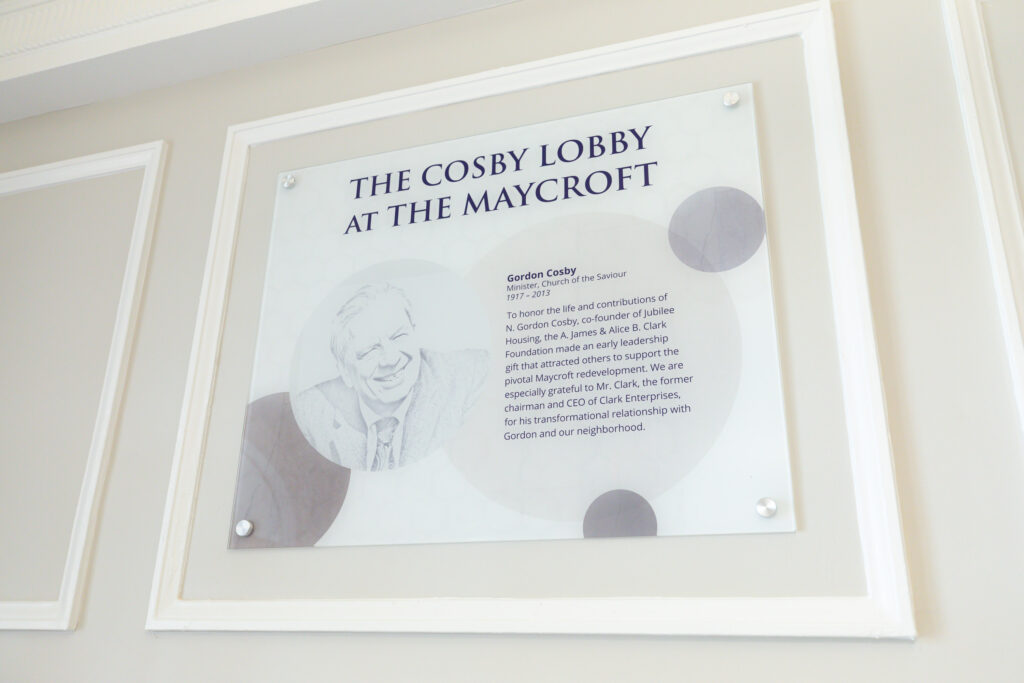As we wrap up our year-long 50th anniversary (Jubilee Year) this month, we honor two of our instrumental founders, Reverend Gordon Cosby and Bill Branner. Gordon was the visionary who formed a new type of church and served the communities’ needs. Bill Branner was the one who made the visions a reality. This is a story of vision and operational intellect that lives on today as Jubilee works to open the nation’s first urban rooftop aquaponics farm associated with affordable housing and a comprehensive workforce development program dedicated to returning citizens and other innovations to improve the lives of the people and families that we work with.
50th Anniversary Stories
Gordon Cosby: Pastor, Mentor, Social Activist, and Visionary
Early Pastoral Experiences
“We’ll be your pastor,” Gordon Cosby said with conviction to the Black congregants of a small rural church in Lynchburg, Virginia. He and his brother had been walking in the Black part of town when they came upon the church. Despite initial skepticism, the members let 16-year-old Gordon preach the following Sunday. Having impressed the small congregation, he led Sunday services for several more years before going to seminary, where his spiritual calling further blossomed.
Years later, Gordon served as a Chaplain throughout World War II. During the Normandy landings on June 6, 1944, later termed “D-day,” Gordon pulled fallen comrades to safety as well as ministered to dying soldiers on the bloody beach.
“’At Normandy, he buried hundreds of young men, including his best friend,’ says Wes Granberg-Michaelson, who knew Cosby for 45 years. ‘As he dealt with young men who were facing death, he realized how poorly equipped they were to deal with the questions of life and death and how poor their faith had prepared them, Granberg-Michaelson says” in an NPR biography of Gordon Cosby.

It was during this witnessing of war, that Gordon promised God that if he survived, he’d dedicate himself to creating a church that supported a deeper connection to faith. Upon the end of World War II, Gordon earned a Silver Star for his service. He returned to the States in 1946. He kept his word and along with six others started a small ecumenical congregation in Adams Morgan.
Gordon had been imagining this small church since he was a teenager, sitting at the dinner table with his childhood sweetheart, Mary. They had a vision of restructuring the church they knew to be more like the church they read about in the New Testament. So, in 1947 when The Church of the Saviour was created, it was the kind of space Gordon and his wife, Mary, had discussed many years before.
The Church of the Saviour was the first place of interracial worship in Washington, DC. One of the tenets of membership in the church was a commitment to service in the community. Members were required to work with the homeless at shelters and the church-run hospice and medical clinic. Cosby’s church would remain small but hold a revolutionary commitment to service and be a haven for discipleship.
As Reverend Cosby’s reputation grew, he received invitations nationwide. One special invitation led to another life-altering experience.
Selma
Imagine standing on the Edmund Pettus Bridge in Selma, Alabama, on March 9, 1965. A bridge where just two days earlier, hundreds of Black men, women, children, and fellow civil rights supporters were beaten with billy clubs and bullwhips for attempting a peaceful march seeking voting rights.
After the nationally televised assault on protesters, also known as Bloody Sunday, Dr. Martin Luther King Jr. summoned White clergy nationwide to walk arm and arm with him across that bridge courageously; to march for justice.
Rev. Cosby received the call inviting him to join 40 other Washington-area ministers on a chartered plane to Selma. On Sunday, March 21st, Rev. Cosby marched with 3,200 people.
Rev. Cosby returned to Washington, DC, with a spirit on fire.
“To be in the midst of the freedom movement…is to touch a spirit and come away changed,” he told his congregation. He brought a burning question to his members: “What is our Selma?”.
As the Church of the Saviour community began reflecting on that question, individuals started exploring ways to address it. Further awakened by the 1968 riots following the assassination of Dr. Martin Luther King, Jr., members of the church became concerned about changes in their neighborhood. They began to connect more deeply with their neighbors, especially those in need. Inspired by Rev. Cosby and the civil rights movement, three young women (Terry Flood, Barbara Moore, and Carolyn Banker Cresswell) who were part of the church community sought to address the deplorable living conditions of their neighbors in the Ritz and Mozart buildings in the Adams Morgan neighborhood. Jubilee Housing was born.
Rev. Cosby’s life up until that Tuesday in Selma mirrored his lifelong commitment to justice, service, and racial unity. The ripple effect was so powerful that dozens of mission groups dedicated to helping the less fortunate were formed in the city and across the country within four decades. Forty mission groups founded by Reverend Cosby are still active in DC today. The Potters House, Christ House, and Jubilee Housing are just a few of the institutions formed from Rev. Cosby’s moments on the Edmund Pettus Bridge. Yet, his influence is engrained into the fabric of the Adams Morgan, Columbia Heights, and Mt. Pleasant communities.

“You’d walk down the block—I still do this now—and everywhere you point, there’s a mission that grew out of the church. These people weren’t talking about some by and by — they were doing it now,” Jim Knight said about his early experience with The Church of the Savior.
The Church of the Savior and Gordon’s spirit is here with us. It’s in every home we build and every program we create.
